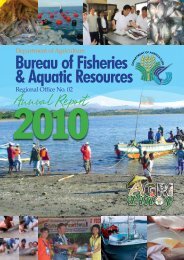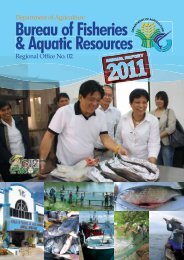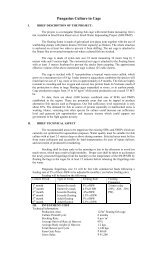Kalap Vol. 10, No. 01, January-June 2009 556kb - Bureau of ...
Kalap Vol. 10, No. 01, January-June 2009 556kb - Bureau of ...
Kalap Vol. 10, No. 01, January-June 2009 556kb - Bureau of ...
Create successful ePaper yourself
Turn your PDF publications into a flip-book with our unique Google optimized e-Paper software.
12<br />
A P A R R I ,<br />
CAGAYAN – Like a<br />
magical well, it has<br />
brought wealth to those<br />
who have drawn from<br />
it.<br />
But no, this is not<br />
some fantasy riches<br />
from fairy land, but a<br />
fishery resource locally<br />
known as aramang.<br />
Aramang or<br />
Nematopalaemon sp<br />
in scientific parlance is<br />
an endemic species in this coastal<br />
town at the northern edge <strong>of</strong> Luzon.<br />
It thrives at the estuarine area <strong>of</strong> the<br />
mighty Cagayan River.<br />
Ricardo Umoso, a long time and<br />
multi-awarded model fisherman, said<br />
that he was able to send seven <strong>of</strong> his<br />
kids and relatives through college<br />
with the bounty from aramang alone.<br />
Umoso, vice chair <strong>of</strong> the<br />
Municipal Fisheries and Aquatic<br />
Resource Management Council,<br />
owns two <strong>of</strong> estimated 60 bannuars<br />
used in catching aramang or s<strong>of</strong>tshelled<br />
shrimp. The municipality also<br />
list about 80 smaller boats known as<br />
‘single-an’ as aramang gatherers.<br />
Hundreds more are employed in<br />
ancillary industries such as<br />
processing, drying, and trading.<br />
Although this fishery resource has<br />
been present since “time<br />
immemorial” as Municipal<br />
Agriculture Officer Alice Sebastian<br />
said, only in the latter part <strong>of</strong> the last<br />
century has this been gathered in<br />
commercial scale.<br />
Data from the <strong>Bureau</strong> <strong>of</strong><br />
Agricultural Statistics indicates<br />
aramang production at a record<br />
4,160 metric tons in 2008. But,<br />
production were not always this<br />
good. There was a time when<br />
Aparrianos nearly lost this resource.<br />
KALAP <strong>January</strong> - <strong>June</strong> <strong>2009</strong><br />
Unwritten agreement helps in resource conservation<br />
Production in 1989 to 1993<br />
plummeted drastically due to<br />
indiscriminate gathering.<br />
Gentlemen’s agreement<br />
Alarmed by the sharp decline,<br />
aramang gatherers met and forged<br />
among themselves a ‘gentleman’s<br />
agreement’. This unwritten but<br />
surprisingly binding rule outlines a<br />
five-point measure that the gatherers<br />
followed to stem the decline and<br />
prevent abuse in the future. The<br />
agreement states that:<br />
• Gathering is allowed only<br />
during daytime from 5AM<br />
to 3PM, good weather<br />
and when aramang are not<br />
gravid<br />
• 5 to 7 days harvest period<br />
with about 15 days as gap<br />
between periods<br />
• A meeting among<br />
gatherers be conducted<br />
first before a gathering<br />
period to set price and<br />
estimate demand<br />
Open season is from April to<br />
<strong>January</strong>. Gathering ban is signified<br />
when a green flag is raised in Brgy.<br />
Punta, near the river mouth here.<br />
Umoso said that with the<br />
enforcement <strong>of</strong> the agreement,<br />
not been threatened since<br />
then.<br />
Bannuar is actually a<br />
fishing outfit that refers to<br />
both the boat and the<br />
fishing gear. It is basically<br />
a drift filter net attached to<br />
two wooden poles fixed at<br />
the aft and fore starboard<br />
<strong>of</strong> the wooden boat which<br />
drifts with the current.<br />
Depth reached by the gear<br />
is about <strong>10</strong> to 12 meters.<br />
One bannuar boat<br />
entails a crew <strong>of</strong> around 15<br />
fishermen. The high number <strong>of</strong> crew<br />
is needed to counterbalance the boat<br />
and prevent it from tilting to one side<br />
and rolling over when there is<br />
abundant catch.<br />
In 2000, the LGU submitted a<br />
request thru the <strong>Bureau</strong> <strong>of</strong> Fisheries<br />
and Aquatic Resources, for the<br />
exemption <strong>of</strong> bannuar among those<br />
banned active gears under a<br />
Fisheries Administrative Order being<br />
promulgated then by the Department<br />
<strong>of</strong> Agriculture, on grounds that use<br />
<strong>of</strong> smaller boats (less than 3 gross<br />
tons) are unsafe and imperils lives <strong>of</strong><br />
fisherfolk.<br />
Subsequent FAO issued has<br />
excluded bannuar as among those<br />
banned fishing gears.<br />
Umoso estimates production <strong>of</strong><br />
one bannuar at 50 cans in one good<br />
day <strong>of</strong> operation. Expenses to cover<br />
gas and food provisions per 5-day<br />
fishing trip is around P 13,000.00.<br />
Catch is usually divided into 26<br />
shares wherein 7 or 8 goes to the<br />
boat owner, 2 or 3 as extra, and one<br />
share each for the crew.<br />
Current price is 300 to 370<br />
pesos per 1 cooking oil can (14 kg).<br />
The fisherfolk prefer to dry the<br />
aramang than sell it fresh specially<br />
aramang stocks rebounded and has (turn to next page)






